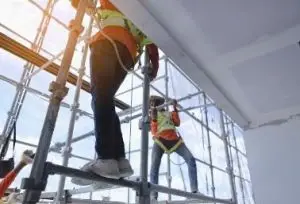When it comes to scaffolds, the possibilities for fall protection are not limitless. However, whether you’re looking for a simple safety net or a more complex system of harnesses and anchors, there’s a solution out there for you. But how do you know which one is right for your project? Keep reading to find out.
What is fall protection?
Fall protection is a system used to protect workers from falling from heights. There are many different types of fall protection, and the type of system used will depend on the specific job and the hazards present. Some common fall protection systems include guardrails, safety nets, positioning devices, and personal fall arrest systems.
What are the requirements for fall protection on scaffolds?
The Occupational Safety and Health Administration (OSHA) requires that all scaffolds 10 feet (3.0 m) or more above a lower level have some form of fall protection. The most common form of fall protection for scaffolds is guardrails.
What are the different types of fall protection?
There are three main types of fall protection for scaffolds:
1. Guardrails – Guardrails are the most common form of fall protection for scaffolds. They consist of a top rail, intermediate rail, and toe board or mid-rail, and are installed around the perimeter of the work platform.
2. Safety nets – Safety nets are installed beneath the work platform and are designed to catch falling workers and debris.
3. Personal fall arrest systems – Personal fall arrest systems consist of a body harness, lanyard, and deceleration device (such as a shock-absorbing lanyard or self-retracting lifeline) and are worn by workers to arrest their fall if they should happen to fall off the scaffold.
How can I ensure that my scaffold is safe?
To ensure your scaffold is safe, follow all OSHA requirements for fall protection on scaffolds. This depends on the type of scaffold being used:
- Supported scaffolds: Must have guardrails on all exposed sides and ends (except at the entrance to the scaffold). Must also be equipped with a stairway or ladder leading to the work platform.
- Suspended scaffolds: Must be equipped with personal fall arrest systems or work positioning devices.
- Aerial Lifts: Must be equipped with a personal fall arrest system or work positioning device.
What are the benefits of fall protection on scaffolds?
There are many benefits of fall protection on scaffolds, including preventing injuries and fatalities, reducing the cost of workers’ compensation claims, and protecting workers from potential falls.
OSHA estimates that each year about 4,500 construction workers suffer serious injuries, such as bone fractures, spinal cord injuries, internal organ damage, and head injury, from scaffold-related Falls. According to the DOL’s Bureau of Labor Statistics (BLS), in 2005 there were 6 deaths caused by scaffold-related Falls per 100,000 full-time equivalents (FTE) workers; this rate was nearly 10 times the rate for all private industries. Many of these can be prevented by using fall protection systems.
By having fall protection in place, workers are less likely to be injured in a fall, which can save companies money on medical bills and lost productivity.
What are the drawbacks of fall protection on scaffolds?
There are several drawbacks to using fall protection on scaffolds, including:
- It can be difficult to attach the fall protection system to the scaffold.
- It can be difficult to move around on the scaffold while wearing fall protection.
- Fall protection can interfere with the work that needs to be done on the scaffold.
- Fall protection can be expensive.
However, the upsides to using fall protection systems will likely outweigh the downsides.
How effective is fall protection on scaffolds?
Fall protection on scaffolds is very effective if worn properly by workers. They can prevent falls that can result in serious bodily injury. They provide a safe and stable platform for workers to stand on while they work in high places. However, scaffolds can also be dangerous if they are not properly used or maintained.
Are there any alternatives to fall protection on scaffolds?
There are three primary types of fall protection for scaffolds: guardrails, safety nets, and personal fall arrest systems. There are few if any effective alternatives to these that will provide protection for workers if they fall.
Guardrails are the most common form of fall protection for scaffolds and are required by OSHA for all scaffolds 10 feet or more above a lower level. Safety nets must be used when guardrails are not possible, such as on slopes or uneven surfaces, or when working with materials that could damage the nets. Personal fall arrest systems must be used when working at heights greater than 20 feet above a lower level, or when working with materials that could damage the nets.
In Closing
While OSHA requires employers to provide fall protection for scaffolds that are at least 10 feet above a lower level, not all employers will follow this rule exactly. So, it is up to the workers to make sure they have adequate fall protection each time they step onto a scaffold.

